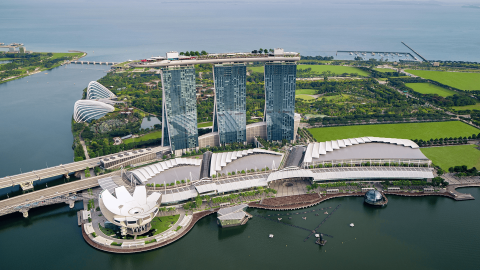Marina Bay Sands (MBS) and Resorts World Sentosa Could See Major Investments: Morgan Stanley Report
Singapore’s casino duopoly is preparing for its most ambitious expansion since the city-state first embraced integrated resorts 14 years ago. A new Morgan Stanley report argues that Marina Bay Sands (MBS) and Resorts World Sentosa, run by Las Vegas Sands and Genting Singapore respectively, will pour another US$10.6 billion (SG$14 billion) into fresh hotel towers, entertainment arenas, and gaming upgrades over the next five years. Although higher gaming and consumption taxes will modestly dent near-term returns, the bank sees the investments lifting revenue, safeguarding Singapore’s 1.5 percent GDP contribution from casinos, and insulating the market against new rivals in Japan, Thailand, and an increasingly assertive Philippines.
Integrated Resorts Have Already Generated Extraordinary Cash Flow
US$30 billion in cumulative EBITDA has been produced since MBS and Resorts World Sentosa opened in 2010, according to Morgan Stanley. That windfall stems from the initial SG$14 billion capital outlay, a favorable 5–15 percent tiered gaming-tax regime, and a transparent licensing structure that froze competitive entry for two decades.
Margin leadership remains intact. Even after COVID-19, the two properties posted EBITDA margins north of 50 percent, well ahead of regional peers in Macau and the Philippines.
The Next SG$14 Billion Will Target Non-Gaming Attractions
Expansion blueprints skew heavily toward tourism infrastructure. Plans include a 15,000-seat entertainment arena at MBS, a fourth hotel tower with 1,000 keys, and a new immersive waterpark plus experiential retail at Resorts World Sentosa.
Return on invested capital (ROIC) will dip temporarily, the bank concedes, but should re-accelerate once projects hit full run-rate in 2029–30.
Tax Headwinds Offset by Tourism Tailwinds
Gaming tax climbs to 18 percent on premium mass and 22 percent on VIP play, up three points since 2022. Goods-and-services tax also rose two points to 9 percent.
Visitor mix is shifting toward higher-spend segments. International arrivals reached 113 percent of pre-pandemic levels in Q1 2025, driven by India, Australia, and an emerging cohort of U.S. leisure travelers. This offsets the slower-than-expected return of mainland Chinese tourists.
Economic Spillovers Underpin Policy Support
22,000 direct jobs and roughly 40,000 indirect roles depend on the casino-anchored resorts. Beyond payroll, MBS and Resorts World funnel billions into local procurement, arts sponsorships, and conference infrastructure, reinforcing their political license to operate.
1.5 percent of national GDP is attributed to the two properties, a figure Morgan Stanley expects to rise once expansion phases are complete.
Singapore’s Competitive Moat: Regulation, Reputation, Reach
Stable governance is a strategic asset. Unlike jurisdictions still drafting casino laws, Singapore offers investors fixed tax bands, predictable licensing timelines, and rigorous—but clear—responsible-gaming protocols.
Iconic architecture sustains premium pricing. The Marina Bay Sands sky-park and Resorts World’s Universal Studios have become must-see landmarks, allowing room-rates that consistently top US$500 on peak nights.
Rival Markets Face Longer Lead Times
Japan’s first integrated resort in Osaka is unlikely before 2030, constrained by environmental reviews and local referenda.
Thailand’s legislative bill remains in draft form, and even best-case scenarios require three to four years for bidding, rezoning, and construction. While Bangkok’s proximity to China is a threat, Singapore’s early-mover advantage and diversified visitor base limit cannibalization risk.
The Philippines is growing fast—Entertainment City posted over US$4 billion in 2024 GGR—but remains segmented by junket volatility and infrastructure gaps.
Shareholder Implications for Genting Singapore and Las Vegas Sands
Higher capex signals confidence, not distress. Genting Singapore ended 2024 with net cash and has earmarked SG$6.8 billion for Phase 2. Las Vegas Sands has ring-fenced roughly US$4.5 billion for MBS upgrades without hindering dividends or buybacks.
Earnings momentum should resume post-2026. Morgan Stanley models double-digit EBITDA growth from 2027 onward as new hotel keys ramp and arena bookings attract incremental visitation.
Societal Safeguards Sustain the Social Contract
Mandatory entry levies for citizens—$110 (SG$150) per day or $1,320 (SG$2,000) annually—are credited with capping local problem-gaming prevalence at below 1 percent.
Data-driven monitoring tools allow regulators to flag unusual betting patterns in real time, a capability still nascent in newer markets.
Actionable Takeaways for Investors and Policymakers
For equity holders: near-term margin softness from construction disruption is likely, but the payoff horizon aligns with most institutional investment cycles. Dollar-cost-averaging into Genting Singapore and Las Vegas Sands could capture the upswing expected from 2027.
For new jurisdictions: Singapore’s blueprint underscores the value of capped licenses, transparent taxes, and stringent—but business-friendly—compliance to attract blue-chip operators and avoid the market fragmentation seen elsewhere.
For the tourism sector: synergistic attractions—concert arenas, Michelin-level dining, and MICE facilities—multiply gaming revenue and insulate against cyclicality.
Higher Casino Competition in the Region
Morgan Stanley’s outlook frames Singapore not merely as a casino success story but as an evolving tourism ecosystem where disciplined reinvestment keeps the destination fresh and globally relevant. With SG$14 billion in new capital about to be deployed, Marina Bay Sands and Resorts World Sentosa are effectively doubling down on a model that has already yielded world-leading margins, iconic architecture, and a measurable lift to national GDP. Investors patient enough to ride out construction noise may find the next chapter even more lucrative than the first.
